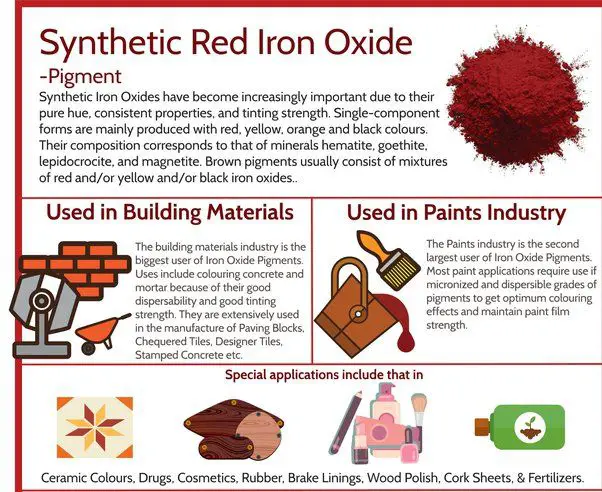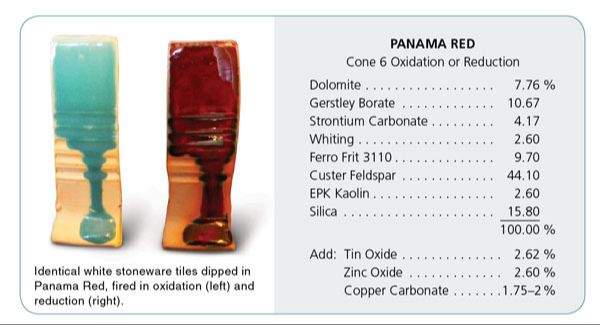Is Red Iron Oxide Food Safe?
What is Red Iron Oxide?
Red iron oxide, also known as iron(III) oxide or ferric oxide, is a chemical compound with the formula Fe2O3. It occurs naturally as the mineral hematite and can also be produced synthetically. Some common names for red iron oxide include rouge, Venetian red, Indian red, Spanish red, and colcothar (Wikipedia Contributors, “Iron oxide red”).
Red iron oxide is an inorganic pigment used since antiquity for painting, as a component of cosmetics, in the production of polishing compounds and also as a reactant in the thermite reaction to produce elemental iron (Wikipedia Contributors, “Iron(III) oxide”). It commonly occurs in iron-rich sedimentary rocks and is the primary ore of iron. Hematite is mined in some of the largest mines in the world, providing the raw material for modern iron and steel production (Wikipedia Contributors, “Iron oxide red”).
Commercially, red iron oxide pigment is produced through a chemical process where hydrated iron oxide is precipitated out of an iron salt solution. The precipitate is then filtered, washed, dried and calcined at temperatures between 600 and 1,200 °C. Controlling factors in the calcination process include temperature, duration and atmospheric conditions, which determine the physical properties of the end product such as hue, opacity and particle size distribution (Wikipedia Contributors, “Iron oxide red”).
Uses of Red Iron Oxide
Red iron oxide has a variety of uses due to its vibrant red color and chemical properties. The most common uses are as a pigment and coloring agent. It is used to add color and tint to paints, plastics, ceramics, cosmetics, inks, and construction materials like concrete and bricks. The redness of iron oxide makes it useful for coloring cement, roofing tiles, stucco, and other masonry materials.
In cosmetics and personal care products, red iron oxide is used in lipstick, eye shadow, blush, and sunscreen for its coloring effect. It is also added to pills and tablets as a coating to provide color. As a pigment, it has low toxicity and good texture, making it suitable for external use in cosmetics.
Red iron oxide also functions as a catalyst in some chemical reactions, and as a curing agent in epoxy resin systems. Its catalytic properties are useful in reactions like the synthesis of ammonia and removal of nitrous oxide. As a catalyst, it helps accelerate reactions without being consumed in the process.
Regulation and Safety

Red iron oxide is approved for use as a food additive and colorant by food regulation agencies in the United States and Europe. In the US, the FDA has approved iron oxides for food use and classifies them as “generally recognized as safe” (GRAS) when used at levels considered safe. Synthetic iron oxides are listed under 21CFR73.200 as exempt from FDA certification requirements, which specifies the maximum levels allowed in food products.
The FDA sets the acceptable maximum levels of iron oxides in foods such as cereals, snack foods, and condiments at 0.5-1.0% by weight. For sausage casings, the level is limited to 2.5% of total casing weight. The EU also permits the use of iron oxides (E172) as food additives with maximum levels set for its use in foods like desserts, condiments, and decorations.
At these permitted levels, red iron oxide is not considered to pose any significant health risks and is generally recognized as safe for food purposes by major health and food regulation agencies.
Source: FDA 21CFR73.200
Benefits
Red iron oxide is considered to have relatively low toxicity compared to other iron compounds like ferrous sulfate or ferric chloride, making it safer for some uses.[1] The iron in red iron oxide is also an essential mineral nutrient for the human body. According to the National Institutes of Health, the recommended daily allowance for iron is 8 to 18 mg per day for adults, with higher amounts for pregnant women.[2] Consuming small amounts of red iron oxide from uses in food, supplements, or cosmetics can therefore provide some of the iron needed in the diet.
Red iron oxide is also considered safe as a color additive in cosmetics when used appropriately. It providesopaque coverage to help even skin tone and prevent skin damage from visible light.[2] Additionally, red iron oxide may help protect against oxidative stress when applied topically.[3] However, moderation is still advised since iron overload can potentially cause skin irritation.
Potential Risks
Iron overload or accumulation of excess iron in the body is one of the main potential risks of consuming red iron oxide. Consuming high doses of supplemental iron can lead to iron toxicity, causing symptoms like nausea, vomiting, diarrhea and stomach pain (NJ.gov).
Those with iron overload conditions like hemochromatosis are at higher risk of complications from consuming supplemental iron (EFSA). Red iron oxide supplements can interact with medications that treat anemia, reducing their effectiveness. Iron supplements can also inhibit absorption of zinc, magnesium and other minerals.
Inhalation of red iron oxide dust over long periods may cause lung inflammation and damage. However some food-grade iron oxide is considered safe for consumption in small amounts.
Occurrence in Foods
Red iron oxide is most commonly found in candies, cereals, and cheeses. It is a commonly used food coloring agent that gives foods a red or pink hue. According to the FDA, red iron oxide is permitted for use in coloring foods generally in amounts consistent with good manufacturing practice.
Some common foods that may contain red iron oxide include:
- Candy – Used to color red candy, licorice, sprinkles, and more
- Breakfast cereals – Used in cereals, granola bars, and other grain-based foods
- Cheese – Added to some processed and pre-packaged cheeses
- Fast foods – Found in some burger patties, pizza, and other fast foods
- Ready meals – Used as a coloring in some pre-made frozen meals and entrees
While natural, some health-conscious consumers try to avoid red iron oxide and other synthetic food dyes in their diet. Checking ingredient labels can help identify if a processed food contains added coloring agents.
Daily Intake
The average daily intake of iron oxides from food is estimated to be around 20-50 mg per day in adults according to the European Food Safety Authority (EFSA) (https://efsa.onlinelibrary.wiley.com/doi/full/10.2903/j.efsa.2016.4482). The main sources of iron oxides in the diet come from cereals, vegetables, and processed foods that contain iron oxide-based food coloring agents such as E172.
The recommended daily intake of iron is 8-18 mg per day for adults depending on age and gender. So the typical intake of iron oxides is well above the levels of recommended iron intake. However, iron oxides have very low bioavailability compared to other forms of iron, with absorption rates estimated around 0.01% (https://efsa.onlinelibrary.wiley.com/doi/full/10.2903/j.efsa.2016.4482). Therefore, iron oxides do not significantly contribute to overall iron nutrition despite the relatively high intake from food sources.
Special Considerations
Red iron oxide has risks for specific populations that should be considered. Children and pregnant women can be particularly sensitive.
According to the Red Iron Oxide Safety Data Sheet, iron oxides are especially concerning for children because they absorb 4-5 times more iron than adults. Excess iron absorption can cause toxicity and organ damage. Pregnant women also tend to absorb more iron, so red iron oxide exposure should be limited.
Those with iron overload disorders like hemochromatosis are at higher risk from any additional iron intake. People with iron sensitivity or allergies may also react negatively to red iron oxide. Consult a doctor before consuming red iron oxide if you have iron regulation issues or sensitivities.
Alternatives
There are a few natural alternatives to using red iron oxide as a food coloring agent. These include:
- Leafy green vegetables like spinach and kale are excellent natural sources of iron. Incorporating more of these iron-rich foods into your diet can help meet your daily iron needs without relying on food additives.
- Beans and lentils also contain significant amounts of iron. Trying dishes made with these iron-rich legumes can provide a natural boost to your iron intake.
- Taking an iron supplement or multivitamin containing iron is another alternative to obtaining iron from food additives. However, supplements may cause constipation or upset stomach in some people.
- Using beet powder as a natural, plant-based coloring agent can give foods a reddish-purple hue without added iron oxide. Other natural colorings like paprika or turmeric can also substitute for synthetic red dyes.
Talk to your doctor if you are concerned about low iron intake or want to avoid specific food additives. They can help determine the best dietary sources of iron and recommended daily amounts based on your health status.
Conclusion
In summary, red iron oxide is generally recognized as safe by health authorities for use as a food additive. It has been approved for usage in food products in many parts of the world. When used within approved limits, it does not pose any significant health risks for most people.
However, those with sensitivity or allergies to iron compounds should avoid or limit consumption of products containing red iron oxide. As with any substance, over-consumption of products with high amounts of red iron oxide could potentially lead to side effects. Moderation is key.
For the general population, enjoying the occasional product containing red iron oxide as an additive is fine. But if you have concerns, aim to minimize exposure or seek natural alternatives without additives. As always, maintaining a balanced, varied diet focused on whole foods is ideal for optimal health.



